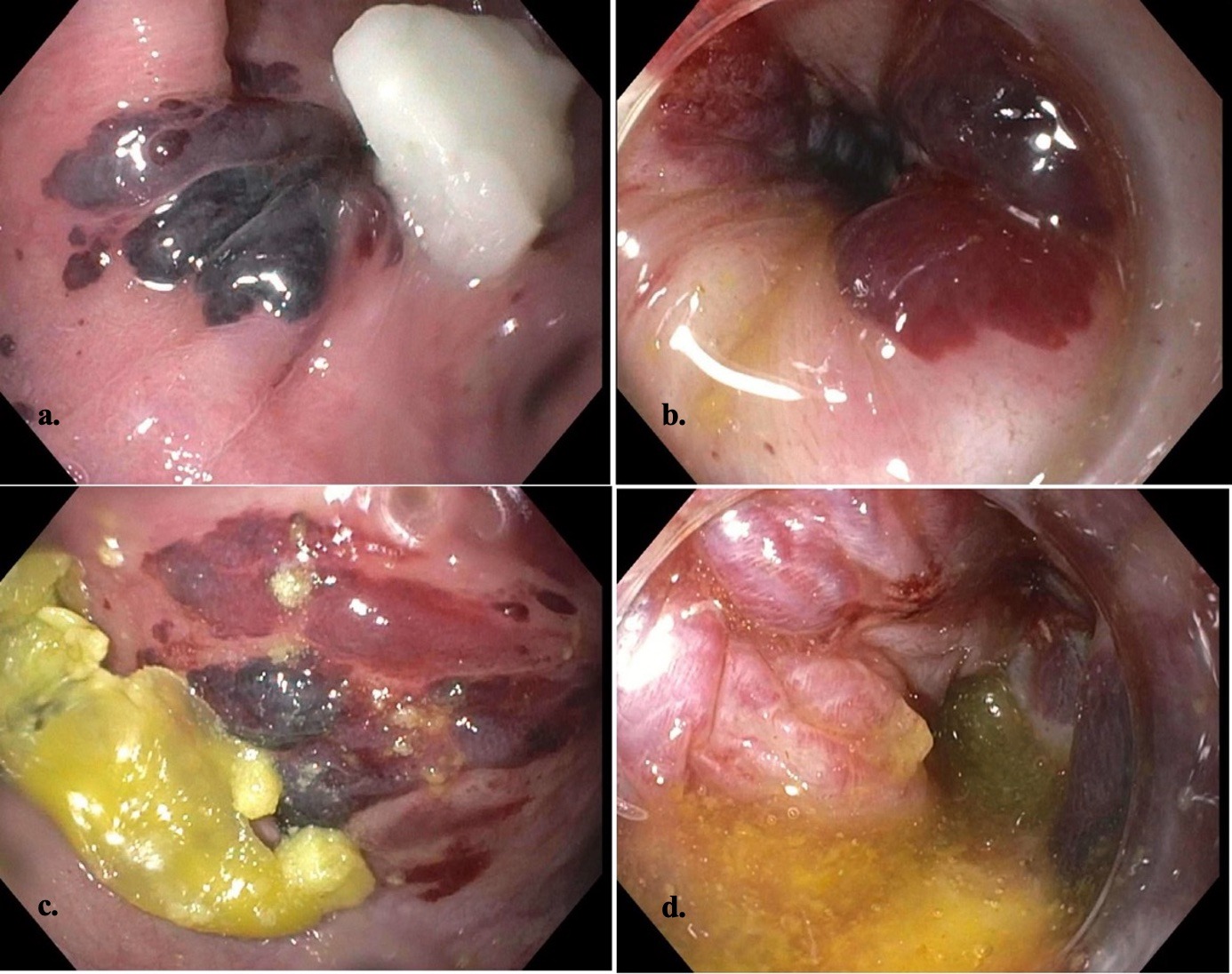Back
Poster Session E - Tuesday Afternoon
E0223 - No Soup for You: The Case of an Intramucosal Hematoma Found During Endoscopy for an Esophageal Food Impaction
Tuesday, October 25, 2022
3:00 PM – 5:00 PM ET
Location: Crown Ballroom

Abdulazeez Swaiti, BS
Brody School of Medicine at East Carolina University
Greenville, NC
Presenting Author(s)
Abdulazeez Swaiti, BS, Shiva Poola, MD, Danielle Hoo-Fatt, MD
Brody School of Medicine at East Carolina University, Greenville, NC
Introduction: Esophageal food impaction (EFI) is third most common gastrointestinal emergency, which is commonly associated with obstructive lesions such as peptic strictures and Schatzki rings, eosinophilic esophagitis and rarely motility disorders. Endoscopic therapy is the mainstay option for the management of EFI if medical therapy fails. The most commonly impacted foods include beef, chicken, pork, and undercooked vegetables with liquids rarely causing an impaction. Complications from a prolonged EFI can result in mucosal disruption to an esophageal perforation. We present an unusual case of an esophageal intramucosal hematoma found in a during endoscopic retrieval of an esophageal impaction.
Case Description/Methods: An 80-year-old male presented with a two-hour history of foreign body sensation in his throat that began while eating hamburger meat and soup with potatoes. He began coughing up a large amount of mucus at symptom onset and was unable to finish his meal. He has been unable to swallow solids or liquids. History was significant for esophageal peptic strictures in the past requiring dilations. After two doses of glucagon failed to help pass the bolus, the patient underwent endoscopic removal of the esophageal food impaction. During the procedure, food was found in the middle and lower thirds of the esophagus and was subsequently removed with suction cap and rat toothed forceps. The esophagus was tortious and was noted to have decreased and abnormal movement throughout with a moderate stenosis found at the gastroesophageal junction. The middle and lower third of the esophagus had localized severe erythema, suspicious for the presence of intramucosal hemorrhage (Figure 1). The patient tolerated a diet after endoscopy and discharged home.
Discussion: Esophageal food impactions are uncommon and are commonly associated with stricture and rings. Complications from a prolonged food impaction include mucosal disruption however findings of an intramucosal hematoma are rare. Intramucosal hematoma present with chest pain, dysphagia, and hematemesis. This patient presented with dysphagia however had no other pain or episodes of hematemesis. In this patient it is unclear whether his presentation was due to an acute EFI causing an intramucosal hematoma or whether the ingestion of soup caused an intramucosal hematoma resulting in an EFI. Nevertheless, one should take caution during endoscopic evaluation for patients who presented with an EFI.

Disclosures:
Abdulazeez Swaiti, BS, Shiva Poola, MD, Danielle Hoo-Fatt, MD. E0223 - No Soup for You: The Case of an Intramucosal Hematoma Found During Endoscopy for an Esophageal Food Impaction, ACG 2022 Annual Scientific Meeting Abstracts. Charlotte, NC: American College of Gastroenterology.
Brody School of Medicine at East Carolina University, Greenville, NC
Introduction: Esophageal food impaction (EFI) is third most common gastrointestinal emergency, which is commonly associated with obstructive lesions such as peptic strictures and Schatzki rings, eosinophilic esophagitis and rarely motility disorders. Endoscopic therapy is the mainstay option for the management of EFI if medical therapy fails. The most commonly impacted foods include beef, chicken, pork, and undercooked vegetables with liquids rarely causing an impaction. Complications from a prolonged EFI can result in mucosal disruption to an esophageal perforation. We present an unusual case of an esophageal intramucosal hematoma found in a during endoscopic retrieval of an esophageal impaction.
Case Description/Methods: An 80-year-old male presented with a two-hour history of foreign body sensation in his throat that began while eating hamburger meat and soup with potatoes. He began coughing up a large amount of mucus at symptom onset and was unable to finish his meal. He has been unable to swallow solids or liquids. History was significant for esophageal peptic strictures in the past requiring dilations. After two doses of glucagon failed to help pass the bolus, the patient underwent endoscopic removal of the esophageal food impaction. During the procedure, food was found in the middle and lower thirds of the esophagus and was subsequently removed with suction cap and rat toothed forceps. The esophagus was tortious and was noted to have decreased and abnormal movement throughout with a moderate stenosis found at the gastroesophageal junction. The middle and lower third of the esophagus had localized severe erythema, suspicious for the presence of intramucosal hemorrhage (Figure 1). The patient tolerated a diet after endoscopy and discharged home.
Discussion: Esophageal food impactions are uncommon and are commonly associated with stricture and rings. Complications from a prolonged food impaction include mucosal disruption however findings of an intramucosal hematoma are rare. Intramucosal hematoma present with chest pain, dysphagia, and hematemesis. This patient presented with dysphagia however had no other pain or episodes of hematemesis. In this patient it is unclear whether his presentation was due to an acute EFI causing an intramucosal hematoma or whether the ingestion of soup caused an intramucosal hematoma resulting in an EFI. Nevertheless, one should take caution during endoscopic evaluation for patients who presented with an EFI.

Figure: Figure 1: Localized severe erythema suspicious for intramucosal hemorrhage. (1a., 1b., 1c.), Lower third of the esophagus. (1d.)- Gastroesophageal junction.
Disclosures:
Abdulazeez Swaiti indicated no relevant financial relationships.
Shiva Poola indicated no relevant financial relationships.
Danielle Hoo-Fatt indicated no relevant financial relationships.
Abdulazeez Swaiti, BS, Shiva Poola, MD, Danielle Hoo-Fatt, MD. E0223 - No Soup for You: The Case of an Intramucosal Hematoma Found During Endoscopy for an Esophageal Food Impaction, ACG 2022 Annual Scientific Meeting Abstracts. Charlotte, NC: American College of Gastroenterology.
